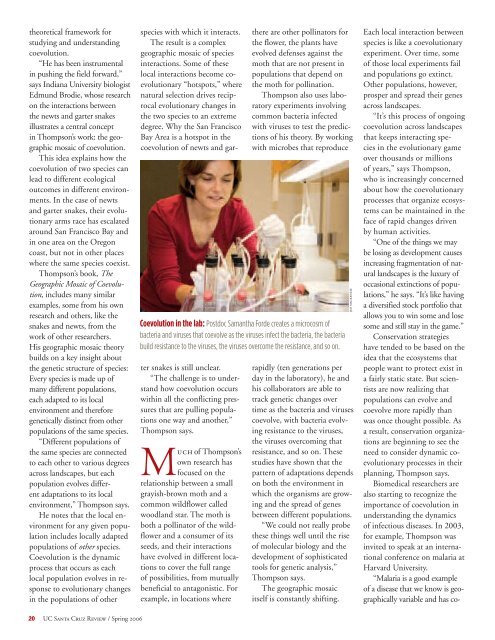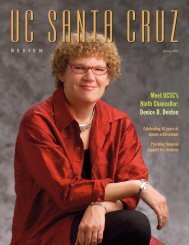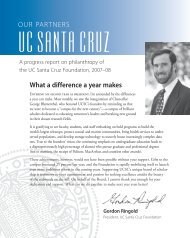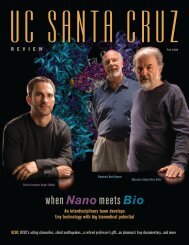Spring - Review Magazine - University of California, Santa Cruz
Spring - Review Magazine - University of California, Santa Cruz
Spring - Review Magazine - University of California, Santa Cruz
Create successful ePaper yourself
Turn your PDF publications into a flip-book with our unique Google optimized e-Paper software.
theoretical framework for<br />
studying and understanding<br />
coevolution.<br />
“He has been instrumental<br />
in pushing the field forward,”<br />
says Indiana <strong>University</strong> biologist<br />
Edmund Brodie, whose research<br />
on the interactions between<br />
the newts and garter snakes<br />
illustrates a central concept<br />
in Thompson’s work: the geographic<br />
mosaic <strong>of</strong> coevolution.<br />
This idea explains how the<br />
coevolution <strong>of</strong> two species can<br />
lead to different ecological<br />
outcomes in different environments.<br />
In the case <strong>of</strong> newts<br />
and garter snakes, their evolutionary<br />
arms race has escalated<br />
around San Francisco Bay and<br />
in one area on the Oregon<br />
coast, but not in other places<br />
where the same species coexist.<br />
Thompson’s book, The<br />
Geographic Mosaic <strong>of</strong> Coevolution,<br />
includes many similar<br />
examples, some from his own<br />
research and others, like the<br />
snakes and newts, from the<br />
work <strong>of</strong> other researchers.<br />
His geographic mosaic theory<br />
builds on a key insight about<br />
the genetic structure <strong>of</strong> species:<br />
Every species is made up <strong>of</strong><br />
many different populations,<br />
each adapted to its local<br />
environment and therefore<br />
genetically distinct from other<br />
populations <strong>of</strong> the same species.<br />
“Different populations <strong>of</strong><br />
the same species are connected<br />
to each other to various degrees<br />
across landscapes, but each<br />
population evolves differ-<br />
ent adaptations to its local<br />
environment,” Thompson says.<br />
He notes that the local environment<br />
for any given population<br />
includes locally adapted<br />
populations <strong>of</strong> other species.<br />
Coevolution is the dynamic<br />
process that occurs as each<br />
local population evolves in response<br />
to evolutionary changes<br />
in the populations <strong>of</strong> other<br />
20 UC <strong>Santa</strong> <strong>Cruz</strong> <strong>Review</strong> / <strong>Spring</strong> 2006<br />
species with which it interacts.<br />
The result is a complex<br />
geographic mosaic <strong>of</strong> species<br />
interactions. Some <strong>of</strong> these<br />
local interactions become coevolutionary<br />
“hotspots,” where<br />
natural selection drives reciprocal<br />
evolutionary changes in<br />
the two species to an extreme<br />
degree. Why the San Francisco<br />
Bay Area is a hotspot in the<br />
coevolution <strong>of</strong> newts and gar-<br />
ter snakes is still unclear.<br />
“The challenge is to understand<br />
how coevolution occurs<br />
within all the conflicting pressures<br />
that are pulling populations<br />
one way and another,”<br />
Thompson says.<br />
Much <strong>of</strong> Thompson’s<br />
own research has<br />
focused on the<br />
relationship between a small<br />
grayish-brown moth and a<br />
common wildflower called<br />
woodland star. The moth is<br />
both a pollinator <strong>of</strong> the wildflower<br />
and a consumer <strong>of</strong> its<br />
seeds, and their interactions<br />
have evolved in different locations<br />
to cover the full range<br />
<strong>of</strong> possibilities, from mutually<br />
beneficial to antagonistic. For<br />
example, in locations where<br />
there are other pollinators for<br />
the flower, the plants have<br />
evolved defenses against the<br />
moth that are not present in<br />
populations that depend on<br />
the moth for pollination.<br />
Thompson also uses laboratory<br />
experiments involving<br />
common bacteria infected<br />
with viruses to test the predictions<br />
<strong>of</strong> his theory. By working<br />
with microbes that reproduce<br />
Coevolution in the lab: Postdoc Samantha Forde creates a microcosm <strong>of</strong><br />
bacteria and viruses that coevolve as the viruses infect the bacteria, the bacteria<br />
build resistance to the viruses, the viruses overcome the resistance, and so on.<br />
jim mackenzie<br />
rapidly (ten generations per<br />
day in the laboratory), he and<br />
his collaborators are able to<br />
track genetic changes over<br />
time as the bacteria and viruses<br />
coevolve, with bacteria evolving<br />
resistance to the viruses,<br />
the viruses overcoming that<br />
resistance, and so on. These<br />
studies have shown that the<br />
pattern <strong>of</strong> adaptations depends<br />
on both the environment in<br />
which the organisms are growing<br />
and the spread <strong>of</strong> genes<br />
between different populations.<br />
“We could not really probe<br />
these things well until the rise<br />
<strong>of</strong> molecular biology and the<br />
development <strong>of</strong> sophisticated<br />
tools for genetic analysis,”<br />
Thompson says.<br />
The geographic mosaic<br />
itself is constantly shifting.<br />
Each local interaction between<br />
species is like a coevolutionary<br />
experiment. Over time, some<br />
<strong>of</strong> those local experiments fail<br />
and populations go extinct.<br />
Other populations, however,<br />
prosper and spread their genes<br />
across landscapes.<br />
“It’s this process <strong>of</strong> ongoing<br />
coevolution across landscapes<br />
that keeps interacting species<br />
in the evolutionary game<br />
over thousands or millions<br />
<strong>of</strong> years,” says Thompson,<br />
who is increasingly concerned<br />
about how the coevolutionary<br />
processes that organize ecosystems<br />
can be maintained in the<br />
face <strong>of</strong> rapid changes driven<br />
by human activities.<br />
“One <strong>of</strong> the things we may<br />
be losing as development causes<br />
increasing fragmentation <strong>of</strong> natural<br />
landscapes is the luxury <strong>of</strong><br />
occasional extinctions <strong>of</strong> populations,”<br />
he says. “It’s like having<br />
a diversified stock portfolio that<br />
allows you to win some and lose<br />
some and still stay in the game.”<br />
Conservation strategies<br />
have tended to be based on the<br />
idea that the ecosystems that<br />
people want to protect exist in<br />
a fairly static state. But scientists<br />
are now realizing that<br />
populations can evolve and<br />
coevolve more rapidly than<br />
was once thought possible. As<br />
a result, conservation organizations<br />
are beginning to see the<br />
need to consider dynamic coevolutionary<br />
processes in their<br />
planning, Thompson says.<br />
Biomedical researchers are<br />
also starting to recognize the<br />
importance <strong>of</strong> coevolution in<br />
understanding the dynamics<br />
<strong>of</strong> infectious diseases. In 2003,<br />
for example, Thompson was<br />
invited to speak at an international<br />
conference on malaria at<br />
Harvard <strong>University</strong>.<br />
“Malaria is a good example<br />
<strong>of</strong> a disease that we know is geographically<br />
variable and has co-<br />
evolved with its host species over<br />
thousands <strong>of</strong> years,” he says.<br />
Human populations differ<br />
in their genetic defenses against<br />
malaria, and the mosquitoes<br />
that transmit the disease also<br />
show geographic variability.<br />
Rapid evolutionary changes<br />
have occurred in both the<br />
malaria parasite and the mosquitoes<br />
in response to the drugs<br />
and insecticides that have been<br />
deployed to fight the disease.<br />
“The question is, how can<br />
we use what we know from<br />
evolutionary biology to develop<br />
better therapies and devise<br />
strategies that will minimize<br />
the evolution <strong>of</strong> resistance<br />
when we come up with new<br />
therapies,” Thompson says.<br />
“We are just beginning the<br />
conversations between disciplines<br />
that will help us answer<br />
those questions.”<br />
Humans have, in fact, been<br />
manipulating the coevolutionary<br />
process for thousands <strong>of</strong><br />
years. The story <strong>of</strong> agriculture<br />
involves a long history <strong>of</strong><br />
human-induced coevolution<br />
between crop plants and<br />
rapidly evolving parasites and<br />
pathogens, Thompson says.<br />
This game <strong>of</strong> surrogate<br />
coevolution continues, going<br />
back and forth between plant<br />
breeders, who are constantly<br />
producing new disease-<br />
resistant crops, and the fungi,<br />
bacteria, and viruses that are<br />
constantly evolving to become<br />
more virulent. A current<br />
example is the emergence in<br />
East Africa <strong>of</strong> a new strain<br />
<strong>of</strong> wheat rust that, according<br />
to biologists who raised the<br />
alarm in September, could<br />
wipe out 10 percent <strong>of</strong> the<br />
world’s wheat production. Of<br />
course, work is already under<br />
way to breed and disseminate<br />
new resistant varieties<br />
<strong>of</strong> wheat to combat this new<br />
strain <strong>of</strong> rust fungus.<br />
As researchers learn<br />
more about how the<br />
coevolutionary process<br />
works and the factors that create<br />
hotspots and coldspots,<br />
they may find new ways <strong>of</strong><br />
manipulating that process.<br />
“We should be able to take<br />
the results from studying coevolution<br />
in the wild and start<br />
applying them to practical<br />
problems,” Thompson says.<br />
Controlled environment: Thompson inspects glass tubes used to conduct<br />
experiments with coevolving flowers and moths.<br />
jim mackenzie<br />
Taking STEPS to advance<br />
environmental research<br />
The theme <strong>of</strong> connectedness runs throughout the work <strong>of</strong> John Thompson,<br />
pr<strong>of</strong>essor <strong>of</strong> ecology and evolutionary biology, and through the activities <strong>of</strong><br />
the institute he directs at UC <strong>Santa</strong> <strong>Cruz</strong>—the STEPS Institute for Innovation in<br />
Environmental Research. The STEPS Institute encompasses science, technology,<br />
engineering, policy, and society in its approach to environmental research, which<br />
it supports through a variety <strong>of</strong> initiatives, workshops, fellowships, and grants.<br />
An interdisciplinary approach to environmental research comes naturally to a<br />
scientist concerned with the interactions between species, the interconnected web<br />
<strong>of</strong> interactions within ecosystems, and the connections between human activities,<br />
ecosystem functions, and the global environment.<br />
“Humans are creating changes in the environment that amount to a set<br />
<strong>of</strong> intertwined global experiments whose long-term effects are unknown.<br />
We don’t really know what’s going to happen down the road,” Thompson says.<br />
The STEPS Institute fosters research and policy efforts that address these<br />
potential effects. Its efforts have coalesced into two initiatives—the Genes to<br />
Ecoregions Initiative and the Regional Climate Change and Water Initiative.<br />
Through these initiatives, the institute is forging new collaborations among faculty<br />
researchers, policy makers, and environmental managers.<br />
Part <strong>of</strong> the Genes to Ecoregions Initiative, for example, is the <strong>Santa</strong> Lucia<br />
Gradient Study, which focuses on a region <strong>of</strong> <strong>California</strong> that is rich in both biological<br />
diversity and jurisdictional complexity. STEPS has hosted workshops at UCSC that<br />
brought together representatives <strong>of</strong> the many governmental and nongovernmental<br />
agencies, private groups, and university researchers studying the remarkable landscape<br />
<strong>of</strong> the <strong>Santa</strong> Lucia Range, which rises steeply from the Big Sur coast. The institute<br />
has developed a “meta-database” <strong>of</strong> biodiversity research in this region—a<br />
comprehensive resource to give researchers access to the results <strong>of</strong> decades <strong>of</strong> past<br />
work by researchers and managers working for different organizations.<br />
The STEPS Institute was established in 2002 with a $500,000 gift from UCSC<br />
alumnus Gordon Ringold and his wife, Tanya Zarucki. Since then, it has provided<br />
fellowships for interdisciplinary graduate research and research grants to faculty,<br />
graduate students, and undergraduate students. Most <strong>of</strong> the funds are for research<br />
projects that either link multiple research laboratories at UCSC or link UCSC laboratories<br />
with outside agencies or policy makers.<br />
Thompson’s current focus for the institute is to increase support for graduate<br />
students interested in environmental research problems that span traditional<br />
disciplines. “We need to train the next generation <strong>of</strong> environmental scientists to<br />
think about problems in a more interdisciplinary way,” he says.<br />
UC <strong>Santa</strong> <strong>Cruz</strong> <strong>Review</strong> / <strong>Spring</strong> 2006 21<br />
john thompson





